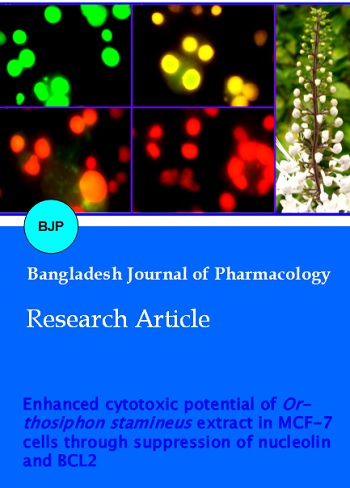Enhanced cytotoxic potential of Orthosiphon stamineus extract in MCF-7 cells through suppression of nucleolin and bcl2
DOI:
https://doi.org/10.3329/bjp.v12i3.32337Keywords:
Anti-cancer, Cleome gynandra, DPPH, MTT, Palmitic acid, Phytol, PhenolAbstract
The aim of the present study was to analyze the anti-cancer effect of Orthosiphon stamineus leaf extract on MCF-7 cells. Ethyl acetate extract of the plant was eluted and pooled into 6 fractions based on their Rf values and the fractions were tested for cytotoxicity. Fraction 3 was found effective (IC50 = 28.5 µL/mL) and was subjected to LC-MS analysis which indicated the presence of biochanin, eleutherol and cinnamic acid. Further, cytotoxic effect of the fraction was confirmed in terms of nucleolin, bcl2, bax and cytochrome c expression in MCF-7 cells through RT-PCR where a marked decrease in nucleolin, bcl2 and increase in bax and cytochrome c were observed. The presence of eleutherol, a well-known anti-oxidant and anti-cancer agent, has been reported for the first time in O. stamineus. The anti-cancer activity of O. stamineus may be due to the presence of elutherol and cinnamic acid.
Video Clip of Methodology:
LC-MS analysis of Orthosiphon stamineus extract: 7 min 33 sec Full Screen Alternate
Downloads
141
182 Read
21

Published
How to Cite
Issue
Section
License
Authors who publish with this journal agree to the following terms:
- Authors retain copyright and grant the journal right of first publication with the work simultaneously licensed under a Creative Commons Attribution License that allows others to share the work with an acknowledgement of the work's authorship and initial publication in this journal.
- Authors are able to enter into separate, additional contractual arrangements for the non-exclusive distribution of the journal's published version of the work (e.g., post it to an institutional repository or publish it in a book), with an acknowledgement of its initial publication in this journal.
- Authors are permitted and encouraged to post their work online (e.g., in institutional repositories or on their website) prior to and during the submission process, as it can lead to productive exchanges, as well as earlier and greater citation of published work (See The Effect of Open Access).
